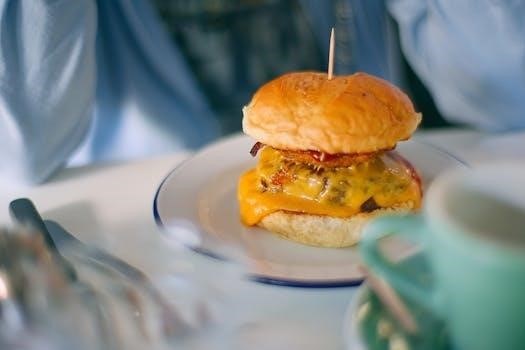Embarking on a 4000 calorie meal plan signifies a dedication to fueling intense physical activity or recovery․ This nutritional strategy, when properly executed, supports significant muscle growth and repair․
Understanding the Purpose of a High-Calorie Diet
A high-calorie diet, such as a 4000 calorie meal plan, serves a distinct purpose⁚ to provide the body with an energy surplus․ This surplus is crucial when energy expenditure significantly exceeds caloric intake․ The primary goal is often to promote weight gain, particularly in the form of lean muscle mass․ This is especially relevant for individuals engaged in intense physical training, such as athletes and bodybuilders, who require extra fuel to support their rigorous workouts and muscle recovery processes․
Furthermore, a high-calorie diet can be essential for those recovering from illness or injury; During recovery, the body needs additional energy to repair damaged tissues and rebuild strength․ Malnourished individuals or those with medical conditions that hinder nutrient absorption may also benefit from a carefully structured high-calorie plan․
However, it’s crucial to understand that simply consuming large quantities of food is not the objective․ A well-designed high-calorie diet emphasizes nutrient-dense foods to ensure the body receives the necessary vitamins, minerals, and macronutrients to support overall health and well-being․ The focus should be on quality over quantity․

Who Needs a 4000 Calorie Meal Plan?
A 4000 calorie meal plan isn’t for everyone․ It’s typically tailored for individuals with high energy demands․ This includes athletes, bodybuilders, or those recovering from specific medical conditions requiring increased caloric intake․
Athletes and Bodybuilders
For athletes and bodybuilders, a 4000 calorie meal plan can be instrumental in achieving peak performance and maximizing muscle growth․ These individuals often engage in rigorous training regimens that demand a significant amount of energy․ The increased caloric intake supports not only their daily activities but also the muscle repair and growth processes that occur after intense workouts․
The precise caloric needs of an athlete or bodybuilder depend on several factors, including their training intensity, body weight, metabolism, and overall goals․ A 4000 calorie plan provides the necessary building blocks for muscle protein synthesis, ensuring that the body has adequate resources to rebuild and strengthen muscle tissue․ Furthermore, the plan can help maintain a positive energy balance, preventing the body from entering a catabolic state where it starts breaking down muscle for fuel․
The composition of the 4000 calories is also crucial․ It should consist of a balanced mix of macronutrients⁚ protein for muscle repair, carbohydrates for energy, and healthy fats for hormone production and overall health․ Timing of nutrient intake is also important, with strategic meals and snacks throughout the day to optimize energy levels and recovery․
Individuals Recovering from Illness or Injury
A 4000 calorie meal plan can be a vital component of recovery for individuals healing from illness, surgery, or significant injuries․ During these periods, the body requires extra energy and nutrients to repair damaged tissues, fight off infection, and rebuild strength․ The increased caloric intake supports the body’s heightened metabolic demands and helps prevent muscle wasting, which can be a common consequence of prolonged inactivity or illness․
The specific nutritional needs during recovery vary depending on the nature and severity of the condition․ However, a 4000 calorie plan can provide a solid foundation for meeting these needs․ Protein is particularly important for tissue repair and immune function, while carbohydrates provide the energy necessary for cellular processes and daily activities․ Healthy fats play a role in reducing inflammation and supporting hormone production․
It’s crucial to prioritize nutrient-dense foods that provide essential vitamins, minerals, and antioxidants․ These micronutrients support the immune system, promote healing, and protect against further damage․ Hydration is also essential, as adequate fluid intake helps transport nutrients, flush out waste products, and maintain overall bodily functions․ A well-designed 4000 calorie meal plan, tailored to the individual’s specific needs and condition, can significantly accelerate the recovery process․

Key Considerations Before Starting
Before initiating a 4000 calorie meal plan, careful planning is essential․ Assess your current caloric intake and activity levels․ Understand your body’s response to increased food consumption․
Consulting with a Healthcare Professional or Dietitian
Before embarking on a 4000 calorie meal plan, seeking guidance from a healthcare professional or registered dietitian is paramount․ These experts can provide personalized advice tailored to your specific health status, goals, and potential underlying conditions․ A doctor can assess your overall health, screen for any contraindications, and monitor your progress throughout the plan․ They can also help you understand potential risks associated with a high-calorie diet, such as increased cholesterol levels or strain on your digestive system․
A registered dietitian, on the other hand, specializes in nutrition and can create a customized meal plan that aligns with your individual needs and preferences․ They can help you select nutrient-dense foods, optimize macronutrient ratios, and ensure you’re meeting your micronutrient requirements․ Furthermore, a dietitian can educate you on proper meal timing, portion control, and strategies for managing hunger and cravings․
The consultation process allows for a comprehensive evaluation of your dietary habits, exercise regimen, and overall lifestyle․ This collaborative approach ensures that the 4000 calorie meal plan is safe, effective, and sustainable for you․ It’s crucial to remember that a one-size-fits-all approach rarely works, and personalized guidance is key to achieving optimal results․

Sample 4000 Calorie Meal Plan (PDF Option)
The following outlines a sample 4000 calorie meal plan for illustrative purposes․ Individual needs vary, so this should be adjusted by a professional; A downloadable PDF version is available for easy access․
Breakfast (Approximately 1000 Calories)
Kickstart your day with a power-packed breakfast designed to deliver approximately 1000 calories․ This crucial meal sets the stage for sustained energy and muscle recovery throughout the morning․ A sample breakfast could include a hearty combination of complex carbohydrates, lean protein, and healthy fats․
Consider options such as⁚
- Oatmeal (1 cup dry) prepared with milk (1 cup) and topped with berries (1/2 cup), nuts (1/4 cup), and a scoop of protein powder․ This provides a balanced mix of carbs, protein, and healthy fats․
- Scrambled eggs (4 large) with cheese (1 oz) and whole-wheat toast (2 slices) with avocado (1/4) for a protein-rich and satisfying start․
- A smoothie made with protein powder, banana, spinach, almond milk, and peanut butter for a quick and easily digestible option․
- Greek yogurt (1 cup) with granola (1/2 cup) and fruit (1 cup) to fuel your body․
Remember to adjust portion sizes to meet your individual needs and preferences while staying within the approximate 1000-calorie target․ Variety is key, so experiment with different combinations to keep your breakfast exciting and enjoyable!
Lunch (Approximately 1000 Calories)
Fuel your afternoon with a substantial lunch designed to provide approximately 1000 calories․ This meal should be strategically balanced to sustain energy levels, support muscle recovery, and prevent mid-day crashes․ A well-composed lunch should include a combination of protein, complex carbohydrates, and healthy fats․
Consider these options⁚
- A large chicken breast (8 oz) with brown rice (1 cup) and steamed vegetables (1 cup)․ This offers a lean protein source with sustained energy from complex carbs․
- A whole-wheat wrap filled with lean turkey, avocado, lettuce, tomato, and hummus․ This is a portable and customizable option․
- A hearty salad with grilled salmon, quinoa, mixed greens, and a light vinaigrette․ This provides a good source of omega-3 fatty acids and fiber․
- Lentil soup (2 cups) with a side of whole-grain bread (2 slices) for a plant-based and filling meal․
Adjust portion sizes based on your individual needs and preferences to stay within the target calorie range․ Remember to stay hydrated by drinking plenty of water throughout the day․ A well-planned lunch is essential for maintaining energy levels and supporting your overall goals․
Dinner (Approximately 1000 Calories)
Concluding your day with a robust dinner is crucial for continued muscle recovery and providing your body with essential nutrients overnight․ This meal, targeting approximately 1000 calories, should be rich in protein, complex carbohydrates, and healthy fats to optimize recovery and promote restful sleep․
Consider these options⁚
- A lean steak (8 oz) with baked sweet potato (1 medium) and roasted asparagus (1 cup)․ This provides a high dose of protein and sustained energy․
- Baked salmon (8 oz) with quinoa (1 cup) and steamed broccoli (1 cup)․ This is rich in omega-3 fatty acids and fiber for optimal health․
- Chicken stir-fry with brown rice (1 cup) and a variety of vegetables․ This is a customizable and flavorful option․
- A large bowl of chili with lean ground beef, beans, and vegetables, topped with a dollop of Greek yogurt․ This is a hearty and satisfying meal․
Prioritize lean protein sources and complex carbohydrates to support muscle repair and glycogen replenishment․ Include healthy fats for hormone regulation and overall well-being․ Adjust portion sizes as needed to meet your individual calorie goals․ Remember to allow sufficient time for digestion before going to bed․
Snacks (Approximately 1000 Calories)
Strategic snacking is paramount when adhering to a 4000 calorie meal plan․ These snacks, totaling around 1000 calories, serve to bridge the gaps between main meals, preventing energy crashes and ensuring a consistent nutrient supply for muscle recovery and growth․ Choose nutrient-dense options rather than empty calories․
Consider these options⁚
- A protein shake with two scoops of protein powder, milk, a banana, and peanut butter․ This is a quick and convenient way to increase protein and calorie intake․
- A handful of mixed nuts and dried fruit․ This provides healthy fats, fiber, and essential nutrients․
- Greek yogurt with granola and berries․ This is a good source of protein, calcium, and antioxidants․
- A whole-wheat bagel with cream cheese and smoked salmon․ This is a balanced snack providing carbohydrates, protein, and healthy fats․
- Avocado toast on whole-grain bread with a sprinkle of red pepper flakes․ This is a healthy and satisfying snack․
Distribute these snacks throughout the day to maintain energy levels and prevent excessive hunger․ Adjust portion sizes as needed to meet your individual calorie needs․ Prioritize whole, unprocessed foods whenever possible;

Tips for Successfully Following the Plan
Successfully navigating a 4000 calorie meal plan requires meticulous planning and consistent execution․ Tracking your intake is crucial; utilize food journals or apps to monitor your progress and ensure you consistently meet your daily calorie target․ Prepare meals in advance to avoid impulsive, less nutritious choices when time is limited․
Stay hydrated by drinking plenty of water throughout the day․ Adequate hydration aids in digestion and nutrient absorption, optimizing your body’s ability to utilize the increased caloric intake․ Prioritize whole, unprocessed foods over processed options to maximize nutrient density and support overall health․
Listen to your body and adjust the plan as needed․ If you experience digestive discomfort or excessive fullness, modify portion sizes or food choices․ Consistency is key, but flexibility is also important․ Don’t be discouraged by occasional setbacks; simply refocus and continue striving towards your goals․ Regular physical activity complements the meal plan, enhancing muscle growth and overall fitness․
